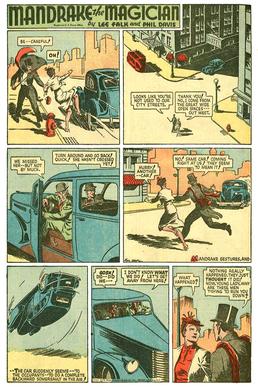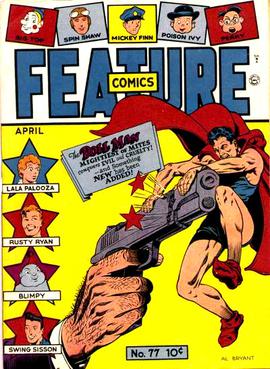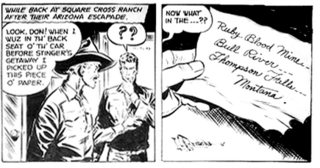
William Erwin Eisner was an American cartoonist, writer, and entrepreneur. He was one of the earliest cartoonists to work in the American comic book industry, and his series The Spirit (1940–1952) was noted for its experiments in content and form. In 1978, he popularized the term "graphic novel" with the publication of his book A Contract with God. He was an early contributor to formal comics studies with his book Comics and Sequential Art (1985). The Eisner Award was named in his honor and is given to recognize achievements each year in the comics medium; he was one of the three inaugural inductees to the Will Eisner Comic Book Hall of Fame.

Quality Comics was an American comic book publishing company which operated from 1937 to 1956 and was a creative, influential force in what historians and fans call the Golden Age of Comic Books.

Mandrake the Magician is a syndicated newspaper comic strip, created by Lee Falk before he created The Phantom. Mandrake began publication on June 11, 1934. Phil Davis soon took over as the strip's illustrator, while Falk continued to script. The strip was distributed by King Features Syndicate.

The Spirit is a fictional masked crimefighter appearing in American comic books. Created by cartoonist Will Eisner, he first appeared as the main feature of a tabloid-sized comic book insert distributed in the Sunday edition of Register and Tribune Syndicate newspapers. Popularly referred to as "The Spirit Section", the insert ran from June 2, 1940 to October 5, 1952.
Spider Widow is a fictional superhero character that was published by Quality Comics during the Golden Age of Comic Books. The character was created by writer and artist Frank Borth, and debuted in Feature Comics #57, which bore a cover date of June 1942. Borth continued to write and draw the Spider Widow feature until the end of its run in Feature Comics #72.

The Funnies is the name of two American publications from Dell Publishing, the first of these a seminal 1920s precursor of comic books, and the second a standard 1930s comic book.

Lady Luck is an American comic-strip and comic-book crime fighter and adventuress created and designed in 1940 by Will Eisner with artist Chuck Mazoujian. She starred in a namesake, four-page weekly feature published in a Sunday newspaper comics insert colloquially called "The Spirit Section", which ran from June 2, 1940, to November 3, 1946. Her adventures were reprinted in comic books published by Quality Comics. A revamped version of the character debuted in 2013 in DC Comics's Phantom Stranger comic.
Bob Powell was an American comic book artist known for his work during the 1930–1940s Golden Age of comic books, including on the features "Sheena, Queen of the Jungle" and "Mr. Mystic". He received a belated credit in 1999 for co-writing the debut of the popular feature "Blackhawk". Powell also did the pencil art for the bubble gum trading card series Mars Attacks. He officially changed his name to S. Robert Powell in 1943.

Everett M. Arnold, also known as Busy Arnold, was an American publisher and an early comic-book entrepreneur whose company Quality Comics published during the 1930s and 1940s period fans and historians call the Golden Age of Comic Books. He was also instrumental in the publishing arrangement that led to Will Eisner's newspaper Sunday-supplement comics series The Spirit.

Smash Comics is the title of an American Golden Age comic book anthology series, published by Quality Comics for 85 issues between 1939 and 1949. It became the series Lady Luck for #86-90.

Feature Comics, originally Feature Funnies, was an American comic book anthology series published by Quality Comics from 1939 until 1950, that featured short stories in the humor genre and later the superhero genre.
The Green Mask is the name of two comic book superheroes, both published by Fox Feature Syndicate. Both are in the public domain with some of the original stories having been reprinted by AC Comics.

Fantomah is an American comics character, best known as one of the earliest comic-book superheroines. Created by Fletcher Hanks, the character first appeared in Jungle Comics #2, published by Fiction House. Hanks is also known for creating the equally strange Stardust the Super Wizard.
Klaus Nordling was an American writer-artist for American comic books. He is best known for his work on the 1940s masked-crimefighter feature "Lady Luck", and as co-creator of the Marvel Comics superhero the Thin Man. Some of the early Nordling's pen names are Fred Nordley, F. Klaus, Ed Norris, and Clyde North.

Don Winslow of the Navy is an American comic strip created by Frank Victor Martinek and was distributed mostly by the Bell Syndicate from 1934 to 1955. The title character was a spy-chasing lieutenant commander in Naval intelligence. The comic strip led to a radio adventure serial that began in 1937, as well as film serials that began in 1942. Original comic book stories also appeared in Fawcett Comics titles starting in 1943.
Audrey Anthony Blum was an American comic book writer active during the 1930s and 1940s "Golden Age of Comic Books", known for her work with Quality Comics and other publishers and as one of the first female comics professionals in what was then an almost entirely male industry.
Eisner & Iger was a comic book packager that produced comics on demand for publishers entering the new medium during the late-1930s and 1940s, a period fans and historians call the Golden Age of Comic Books. Founded by Will Eisner and Jerry Iger, many of comic books' most significant creators, including Jack Kirby, entered the field through its doors. Eisner & Iger existed from 1936 to 1939.
The Register and Tribune Syndicate was a syndication service based in Des Moines, Iowa, that operated from 1922 to 1986, when it was acquired by King Features to become the Cowles Syndicate affiliate. At its peak, the Register and Tribune Syndicate offered newspapers some 60 to 75 features, including editorial cartoonist Herblock, comic strips, and commentaries by David Horowitz, Stanley Karnow, and others.
Jim Hardy is a 1936-1942 American adventure comic strip written and drawn by Dick Moores and distributed by United Features Syndicate. It was Moores' first solo comic strip work, before he gained renown for his work on Gasoline Alley. The strip told the story of Jim Hardy, a down-on-his-luck "man against the world".











